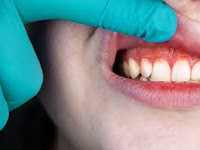The root is covered by a bonelike substance called cementum, and that’s what the periodontal ligament’s fibers attach to. Next, there’s a short zone called the neck, which is the transition between the roots
The crown.
The crown is the visible part of the tooth that protrudes from the gingiva, and it’s covered in enamel. Enamel has such a high mineral content that it’s the hardest substance in the human body. The portion of gingiva that sticks up and is not anchored to the tooth is sometimes called the free gingiva, and the space between the free gingiva and the crown is called the gingival crevice or gingival sulcus. A watery substance called gingival crevicular fluid flows into this space in small amounts. The gingival crevicular fluid contains various immune proteins and cells like neutrophils, complement proteins, and antibodies. Within the mouth, there are a number of bacterial organisms. In a healthy mouth, there is a balance of commensal bacteria that compete, and they are all kept in check by immune factors in the mouth. Gingivitis and periodontitis represent a state of imbalance or dysbiosis. This is when there’s a relative increase in pathogenic bacteria either because of a lack of competition with other commensal bacteria or because of an ineffective immune response.
 |
| Gingivitis and periodontitis |
Buy Now
THE MOUTH. The pathogenic bacteria form dental plaque, which is a sticky collection of bacteria, proteins from saliva, and dead cells from the lining of the mouth. Individual bacteria multiply and form many small microcolonies that coalesce, creating a layer of dental plaque - which is a type of biofilm. Compared to a microcolony, the bacteria in a biofilm communicate with each other via chemical signaling and together they create a complex system where some bacteria work on tunneling between the microcolonies and to the surface to bring in a steady supply of food. As an analogy, if bacteria were ants, then a microcolony would be a tiny group of ants, each doing its own thing, whereas a biofilm would be an ant farm with complex tunnels
and rooms, and each
ant carrying out a specialized task. Some tooth surfaces like the portion of
the tooth just outside the gingiva are hard to brush dental plaque away from.
If dental plaque above the gingiva keeps building, the bacteria within that
biofilm can invade beneath the gingiva where it becomes very difficult to reach
with brushing. Eventually, it can form a hard mass, called a dental calculus.
Dental calculus creates a nice space for bacterial plaque formation, because
it’s hard to remove, and from there bacteria can enter the gingival sulcus and
cause gingival inflammation, or gingivitis.
Damaged gingival
cells release inflammatory signals that recruit neutrophils to the area, and
those neutrophils can release harmful chemicals that kill bacteria, as well as
damage the nearby tissue. Fortunately, simple gingivitis is a reversible
condition, and the damaged tissue can heal
over time as long as
the infection is stopped and treated. In periodontitis, the process of
dysbiosis is often more extreme - with even more disease-causing bacteria
flourishing in the mouth. One classic hypothesis suggests that the first step
in periodontitis is the presence of the so-called orange-complex of bacteria,
which includes gram-negative anaerobic bacteria
like Fusobacterium nucleatum and Prevotella intermedia.
 |
| Gingivitis and periodontitis |
Once these orange-complex bacteria are established, the next step is the presence of the so-called red-complex of bacteria, which includes Tannerella forsythia, Treponema identical, and, its most notorious member, Porphyromonas gingivalis or P. gingivalis for short. Another line of thinking suggests that rather than these red-complex bacteria being the specific culprits, it’s the overall change in the bacterial community that these bacteria trigger that tips the scale toward periodontitis. Either way, the pathogenic bacteria within the subgingival dental plaque create a periodontal pocket and damage gingival cells in the process.
Local mast cells and nerves release chemicals like histamine and substance P which cause dilation of local blood vessels, resulting in swelling of the gingiva. Damaged gingival cells release additional cytokines like interleukin-1, which brings more immune cells to the area, like neutrophils and macrophages. The body’s immune response causes even more damage to the gingiva and periodontal ligament, ultimately loosening the tooth.
If you have any Doubts.Please let me know.